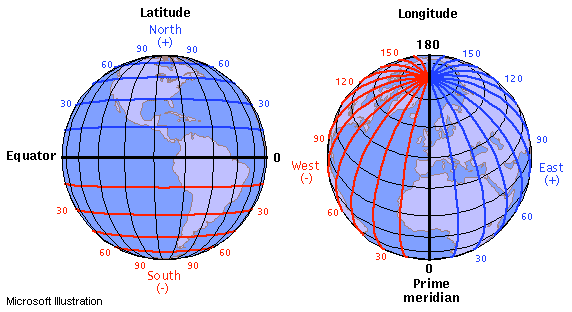Latitude
and Longitude: Your Global Address
Every location on earth has a global address. Because the address is in
numbers, people can communicate about location no matter what language
they might speak. A global address is given as two numbers called coordinates.
The two numbers are a location's latitude number and its longitude number
("Lat/Long").
 Credit: Illinois State University |
Grid
Mapping
Using Lat/Long is different from using a street address. Instead of having
a specific street address, Lat/Long works with a numbered grid system,
like what you see when you look at graph paper. It has horizontal lines
and vertical lines that intersect. A location can be mapped or found on
a grid system simply by giving two numbers which are the location's horizontal
and vertical coordinates; or, to say it another way, the "intersection"
where the place is located).
Grid Mapping a Globe:
Latitude and Longitude lines are a grid map system too. But instead of
being straight lines on a flat surface, Lat/Long lines encircle the Earth,
either as horizontal circles or vertical half circles.
Latitude
Horizontal mapping lines on Earth are lines of latitude. They are known
as "parallels" of latitude, because they run parallel to the equator.
One simple way to visualize this might be to think about having imaginary
horizontal "hula hoops" around the earth, with the biggest hoop
around the equator, and then progressively smaller ones stacked above and
below it to reach the North and South Poles.
(Can you think of other ways to visualize the parallels of Latitude?)

|
Think
about having imaginary horizontal "hula hoops" around
the earth, with the biggest hoop around the equator, and then
progressively smaller ones stacked above and below it to reach
the North and South Poles |
Latitude lines are a numerical way to measure how far north or south of the equator a place is located. The equator is the starting point for measuring latitude--that's why it's marked as 0 degrees latitude. The number of latitude degrees will be larger the further away from the equator the place is located, all the way up to 90 degrees latitude at the poles. Latitude locations are given as __ degrees North or __ degrees South.
Longitude
Vertical mapping lines on Earth are lines of longitude, known as "meridians".
One simple way to visualize this might be to think about having hula hoops
cut in half, vertically positioned with one end at the North Pole and the
other at the South Pole.

|
Visualize
hula hoops cut in half, vertically positioned with one end at
the North Pole and the other at the South Pole. |
Longitude lines are a numerical way to show/measure how far a location is east or west of a universal vertical line called the Prime Meridian. This Prime Meridian line runs vertically, north and south, right over the British Royal Observatory in Greenwich England, from the North Pole to the South Pole. As the vertical starting point for longitude, the Prime Meridian is numbered 0 degrees longitude.
To measure longitude east or west of the Prime Meridian, there are 180 vertical longitude lines east of the Prime Meridian and 180 vertical longitude lines west of the Prime Meridian, so longitude locations are given as __ degrees east or __ degrees west. The 180 degree line is a single vertical line called the International Date Line, and it is directly opposite of the Prime Meridian.
| Try it! The Mystery Class Challenge |
|
| Mystery Class is a global game of hide-and-seek. Students track seasonal changes in sunlight to find ten secret sites around the world. More... | |



